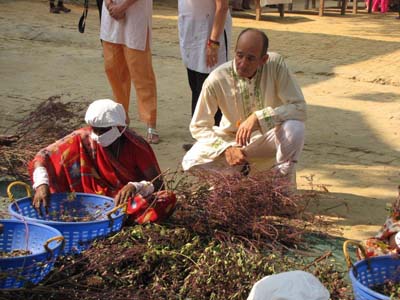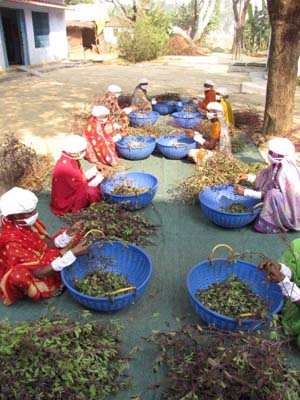
The 'Massive Con' Causing a Suicide Every 30 Minutes
Dr. Mercola
It's been called the "largest wave of recorded suicides in human historyi."
Indian farmers have been robbed of their livelihoods, causing them to take their own lives in despair.
Over the past 16 years, it is estimated that more than a quarter of a million Indian farmers have committed suicide.
Who is responsible for this tragedy?
The most obvious culprits are global corporations like Monsanto, Cargill and Syngenta and the genetically engineered seed they have forced upon farmers worldwide.
None are hit harder than those in India, where socioeconomic and environmental factors have magnified the impact, making it almost impossible for these farmers to survive.
In fact, genetically engineered seeds are so fundamental to the problem that it's been termed "GM Genocide."ii
The rate of Indian farmer suicides has greatly increased since the introduction of Bt cotton in 2002iii.
This is not a pleasant subject to read about, but it is a necessary one… one that can help you understand why it's so important to continue fighting seed monopolies with ever-increased resolve.
I experienced the Indian farmers' plight firsthand while spending two weeks in India, where I saw for myself the devastating effects of GM seed upon the lives and livelihoods of these rural farmers.
I worked closely with Organic India, a company helping more than 150,000 farmers change back to time-honored methods of producing high quality plants and herbs. If you have any doubts about the dire global implications of GM crops, the plight of these farmers should put those doubts to rest.

I personally visited India when I met with Organic India.
A Farmer Commits Suicide by Pesticide Every 30 Minutes in India
The statistics are staggering. According to a publication from the New York University School of Lawiv, in 2009 alone (the most recent year for which official figures are available) 17,638 Indian farmers committed suicide—that's one farmer every 30 minutes. A great number of those affected are cash crop farmers, and cotton farmers in particular.
Cotton exemplifies India's general shift toward cash crop cultivation, a shift that has contributed significantly to farmer vulnerability. The cotton industry, like other cash crops in India, has been dominated by foreign mega-corporations that promote genetically modified seeds and exert increasing control over the entire agricultural industry. Most farmer suicides are a direct result of overwhelming indebtedness. And the suicide numbers may be grossly underestimated.
According to the authors of the NYU report:
"While striking on their own, these figures considerably underestimate the actual number of farmer suicides taking place. Women, for example, are often excluded from farmer suicide statistics because most do not have title to land—a common prerequisite for being recognized as a farmer in official statistics and programs."
The general trend over time is increasing suicides, despite the generally decreasing numbers of Indians performing farming each year, which makes the statistics even starker: It's estimated that more than 250,000 Indian farmers have committed suicide so far. But this problem is not limited to India, as the suicide rate for farmers is higher worldwide than for the non-farming population.
In the Midwestern U.S., suicide rates among male farmers are twice that of the overall population. In Britain, one farmer commits suicide every week.v
For every Indian farmer who takes his own life, a family is hounded by the debt he leaves behind, typically resulting in children dropping out of school to become farmhands, and surviving family members themselves frequently committing suicide out of hopelessness and despair. The Indian government's response to the crisis—largely in the form of limited debt relief and compensation programs—has failed to address the magnitude and scope of the problem or its underlying causes.vi
India's "Suicide Belt"
India is an agrarian country, populated by 1.1 billion people, about 60 percent of whom are directly or indirectly dependent on agriculture. Two-thirds of farmer suicides occur in five Indian states/territories, which has come to be known as India's "Suicide Belt": Maharastra, Karnataka, Andhra Pradesh, Madhya Pradesh, and Chattisgarh. The worst area is Maharastra. In 2007, there were 4,238 farmer suicides in this state alone, accounting for one fourth of the total farmer suicides in India that year. These territories represent zones of highly diversified, commercialized agriculture where cash crops dominate—especially Bt cotton, grown from Monsanto's genetically modified cotton seed. So, what is it about genetically engineered seed that is so damaging for Indian farmers?
Genetically Engineered Seeds Spell Global Disaster
There are four primary factors directly related to the use of genetically engineered seed that contribute heavily to this grim situation:
- Compared to traditional seed, genetically engineered seeds are very expensive and have to be repurchased every planting season
- Genetically engineered crops require much more water to grow, have much higher requirements for fertilizer and pesticide, in spite of Monsanto's claims to the contraryvii and, in spite of their cost to farmers, provide NO increased yield
While companies like Monsanto have plenty of blood on their hands, additional social, economic and environmental factors make matters worse for these small rural farms:
- The "Green Revolution" of the 1960s and 1970s has funneled money toward the middle class and away from the farming/peasant classes
- Rising prices for seeds, fertilizers, pesticides, and other farm supplies, along with falling prices for farm commodities, are forcing farmers to take out high-interest loans from opportunistic moneylenders
- A trend from polyculture farming (diverse crops) to monoculture farming (primarily cotton) has depleted the soil and increased crop infestation by opportunistic pests
- Limited water supplies, periodic drought, decreased monsoonal rainfall, and poor access to irrigation
- Dishonest, predatory salesmen; lack of government support; and grossly inadequate government relief programs

Here I am with local Indian farmers.
Green Revolution Not Kind to Small Indian Farmers
The introduction of hybrid seeds marked the beginning of the current issues plaguing Indian farmers today. Prior to the 1960s and 1970s, Indian farmers grew diverse food crops, but that all changed with the Green Revolution as modern machinery, chemical pesticides and fertilizers, and hybrid seeds were introduced from the West. Most farmers in India now plant cash crops for export, rather than rice, legumes, millet, and other foods for local consumption.
And in India, cotton is king.
In 1998, under the World Bank's new lending policies, India opened its seed sector to international agribusiness, forcing small cotton farms to compete with giant cotton plantations in the West. Companies like Monsanto promoted their new hybrid seed technology. However, it was soon discovered that the new high-tech cotton required more water and more chemicals to grow. This was not good for small Indian farmers, for whom both money and water were, and still are, in short supply.
Seeds of Evil
In 2002, Monsanto "came to the rescue" with the introduction of even higher-tech seeds: genetically engineered Bt cotton. The company claimed that these miracle seeds were a dream come true for farmers everywhere—more pest resistant, higher yields, etc. Bt cotton contains a bacteria gene, an insecticide that repels bollworm, cotton's most voracious parasite.
But this genetically engineered cotton actually required far MORE water and far MORE pesticides than hybrid or traditional cotton!
These seeds were heavily marketed in India, using film stars and even religious deities to lure farmers in. And they came with a steep price tag—they are four to 10 times more expensive than hybrid seeds. Prior to hybrids, farmers were able to harvest their own seeds from each crop, to be planted next season. However, many genetically engineered seeds contain "terminator technology," meaning they have been genetically modified so that the resulting crops don't produce viable seeds of their own. Therefore, new seeds must be purchased every year from big seed companies, at the same punitive prices.
Bt Cotton is a Debt Trap
Bt cotton requires more pesticide sprayings than indigenous cotton—MANY times more. Bt cotton has created new resistant pestsviii, and to control these, farmers must use 13 times more pesticidesix than they were using prior to its introduction. Rates of infestation by aphids, thrips, jassids, and other pests have risen since Bt cotton's introductionx.
Meanwhile, yields for Bt cotton are disappointingly low. Monsanto claims Bt cotton will yield 1500 kg per year, but farmers have gotten only 300 to 400 kg per year, average. High costs and unreliable output make GM cotton a debt trap. According to Voltairenet.org:
"When Monsanto first introduced Bt cotton in 2002, the farmers lost one billion rupees due to crop failure. Instead of 1,500 kilos per acre as promised by the company, the harvest was as low as 200 kilos per acre. Instead of incomes of 10,000 rupees an acre, farmers ran into losses of 6,400 rupees an acre… Poor peasants of the South cannot survive seed monopolies. The crisis of suicides shows how the survival of small farmers is incompatible with the seed monopolies of global corporations."
This has all been amplified by the dramatic fall in cotton prices as a result of the WTO's free trade policies, which make cotton farming financially unsustainable. Foreign agricultural subsidies have driven down the price of crops on the global market, and unsubsidized Indian farmers can't compete.
In 1994, one pound of raw cotton fetched $1.10. In 2006, that same pound brought in a meager 54 cents. A study carried out by the Research Foundation for Science, Technology and Ecology (RFSTE) shows that due to falling farm prices, Indian peasants are losing $26 billion annually.
Add to All of That a Water Shortage
Bt cotton requires irrigation, which only 10 percent of Indian farmers have. The other 90 percent depend on monsoonal rainfall, and in drought years, they risk losing their crops, their financial investment, and even their land.
Droughts are becoming more frequent due to the changing climate. Rains have largely failed for the past several years, and many genetically engineered crops have simply withered and died, leaving the farmers with crippling debts and no means of paying them off.
One studyxi showed that, although most Bt cotton seed packets carry the information that they are "best grown in irrigated conditions" (in fine print), NONE of the homes of suicided farmers had irrigated land. These farmers aren't educated about what it takes to make these seeds grow and the potential risk for total crop failure. And many farmers are completely illiterate and sign on the dotted lines without the benefit of reading, much less understanding, a contract.
And a Banking Shortage…
Another factor contributing to the problem is that farmers no longer have access to good loans. Thousands of rural bank branches have shut down since 1993, redirecting their lending away from farmers and toward elite city dwellers in Mumbai and Delhi, where high-tech growth and technology is booming. Lacking the financial means to pay for high-tech seeds and chemicals, about 80 percent of Indian farmers can borrow only from private moneylenders, who charge exorbitant interest rates. In order to obtain these loans, they must put up their land as collateral. When their crops fail, they lose everything and become servants to the moneylenders.
Many seed dealers operate like America's infamous subprime mortgage lenders.
India has an army of salesmen out selling farm products to farmers who can't afford them. A famer is manipulated into the deal with high-pressure sales tactics, and then borrows from a moneylender to do the deal. When his harvests fail, he has no choice other than to borrow even more. This marks the beginning of a downward spiral of indebtedness and despair. After crops fail and moneylenders hover like buzzards over their decimated fields, many farmers take their lives by ingesting the very pesticides they went into debt to purchase, suffering slow, agonizing deaths.
India's Farmers are Abandoned and Forgotten by their Government
The Indian government used to have agricultural extensions to help farmers, but those days are gone. Farmers now have no one to turn to for advice, except for predatory seed salesmen who don't have the farmers' best interests in mind. The Indian farmers have lost faith in their government, and who could blame them?
The government's priority is clearly India's new urban high-tech based economy. Corrupt officials are disinterested in protecting farmers, and little money is spent on infrastructure, in spite of the fact that 70 percent of Indians live in rural areas. Until the government begins to address irrigation, rural credit, and regulation of the business practices of multinational corporations, the farmer suicide crisis will unfortunately continue.
Genetic Engineering Brings Magnitude 10 Dangers
Genetically tinkering with the human food supply… what could possibly go wrong? Plenty, as it turns out. The potential dangers of genetically engineered food run the gamut, including:
- Contamination of organic crop varieties
- Development of herbicide-resistant super weeds
- Organ disruption, cancer, and increased rate of miscarriage and infertility in animals raised on genetically engineered feed
- Air and rain samples contaminated with glyphosate, and waterways in agricultural areas contaminated with a genetically engineered bug-killing protein
- A brand new organism related specifically to genetically engineered crops, found to be responsible for disease and sudden death in both plants and mammals
The potential risks of genetically engineered crops are so enormous that I have devoted an entire segment of Mercola.com to the subject.
The Importance of Buying Organic Cotton
A few Indian farmers have decided to switch to growing organic cotton. There are numerous advantages, of course, from the standpoint of health—but there are also financial advantagesxii. A minimum price for organic cotton is guaranteed. And the cost of growing organic cotton declines over time as the ecosystem regains its balance.
Organic cotton fields may harbor a few bollworms, but you'll also find plenty of helpful insects, such as ladybugs, and birds that help keep pests under control. Organic farmers make their own insecticides from a renewable mixture of cow dung, cow urine, and butter, and compost fertilizers as well.
You Can Help the Indian Farmers' Plight
Monsanto has been ruthless in their drive to use India as a testing ground for genetically modified crops, and it gives us a very clear picture of what could be in store for the rest of the world's small farmers if GM seed conglomerates are allowed to continue. This is why it's so important to vote with your pocket book, being vigilant about not purchasing GM foods.
I have visited thousands of Indian farmers who've escaped the clutches of Monsanto, thanks to the efforts of Organic India that has taught them how to grow crops organically. Organic India has also constructed a number of hospitals and clinics to serve these farmers, which has helped tremendously in restoring their dignity.
Your best strategy, to help both yourself and small organic farmers everywhere, is to buy USDA 100% Organic products whenever possible, (as these do not permit genetically engineered ingredients) or buy whole fresh produce and meat from local farmers. The majority of the genetically engineered crops you're exposed to are via processed foods, so by cooking from scratch with whole foods, you can be sure you're not inadvertently consuming something laced with genetically engineered ingredients. When you do purchase processed food, avoid products containing anything related to corn or soy that are not 100 percent organic, as any foods containing these two non-organic ingredients are virtually guaranteed to contain genetically engineered ingredients, as well as toxic herbicide residues.

Here I am with Organic India and local Indian Farmers.
You may also find this Non-GMO Shopping Guide helpful, created by the Institute for Responsible Technology. Share it with your friends and family, and post it to your social networks. You can also download a free iPhone application, available in the iTunes store. You can find it by searching for "ShopNoGMO" in the applications. To learn more, I highly recommend the following films and lectures:
Important Action Item: Support California's Ballot Initiative to Label GMO's!
In 2007, then-Presidential candidate Obama promised to "immediately" require GM labeling if elected. So far, nothing of the sort has transpired.
Fortunately, 24 U.S. states have (as part of their state governance) something called the Initiative Process, where residents can bring to ballot any law they want enacted, as long as it has sufficient support. California has been busy organizing just such a ballot initiative to get mandatory labeling for genetically engineered foods sold in their state. The proposed law will be on the 2012 ballot.
Michigan and Washington are also starting similar campaignsxiii.
Since California is the 8th largest economy in the world, a win for the California Initiative would be a huge step forward, and would affect ingredients and labeling nation-wide. A coalition of consumer, public health and environmental organizations, food companies, and individuals has submitted the California Right to Know Genetically Engineered Food Act to the State Attorney General. Now, they need 800,000 signatures to get the Act on this year's ballot.
Proof Positive that GMO Labeling WILL Change the Food Industry
Many don't fully appreciate the strategy of seeking to have genetically engineered foods labeled in California. The belief is that large companies would refuse to have dual labeling; one for California and another for the rest of the country. It would be very expensive and a logistical nightmare. So rather than have two labels, they would simply not carry the product, especially if the new label would be the equivalent of a skull and crossbones. This is why we are so committed to this initiative as victory here will likely eliminate genetically engineered foods from the US.
Powerful confirmation of this belief occurred in early 2012 when both Coca-Cola Company and PepsiCo Inc. chose to alter one of their soda ingredients as a result of California's labeling requirements for carcinogensxiv:
"Coca-Cola Co. and PepsiCo Inc. are changing the way they make the caramel coloring used in their sodas as a result of a California law that mandates drinks containing a certain level of carcinogens bear a cancer warning label. The companies said the changes will be expanded nationally to streamline their manufacturing processes. They've already been made for drinks sold in California."
This is a PERFECT example of the national impact a California GMO labeling mandate can, and no doubt WILL, have. While California is the only state requiring the label to state that the product contains the offending ingredient, these companies are switching their formula for the entire US market, rather than have two different labels. According to USA Today:
"A representative for Coca-Cola, Diana Garza Ciarlante, said the company directed its caramel suppliers to modify their manufacturing processes to reduce the levels of the chemical 4-methylimidazole, which can be formed during the cooking process and as a result may be found in trace amounts in many foods. "While we believe that there is no public health risk that justifies any such change, we did ask our caramel suppliers to take this step so that our products would not be subject to the requirement of a scientifically unfounded warning," Garza-Giarlante said in an email."
You CAN Make a Difference
I urge you to get involved and help in any way you can. Be assured that what happens in California will affect the remainder of the U.S. states, so please support this important state initiative, even if you do not live there!
- Whether you live in California or not, please donate money to this historic effort
- Talk to organic producers and stores and ask them to actively support the California Ballot. It may be the only chance we have to label genetically engineered foods.
- Distribute WIDELY the Non-GMO Shopping Guide to help you identify and avoid foods with GMOs. Look for products (including organic products) that feature the Non-GMO Project Verified Seal to be sure that at-risk ingredients have been tested for GMO content. You can also download the free iPhone application that is available in the iTunes store. You can find it by searching for ShopNoGMO in the applications.
- For timely updates, please join the Organic Consumers Association on Facebook, or follow them on Twitter.
- Look for in-depth coverage of the issue at the Institute for Responsible Technology, subscribe to Spilling the Beans, and check out their Facebook or Twitter.
VIEW ALL VIDEOS

